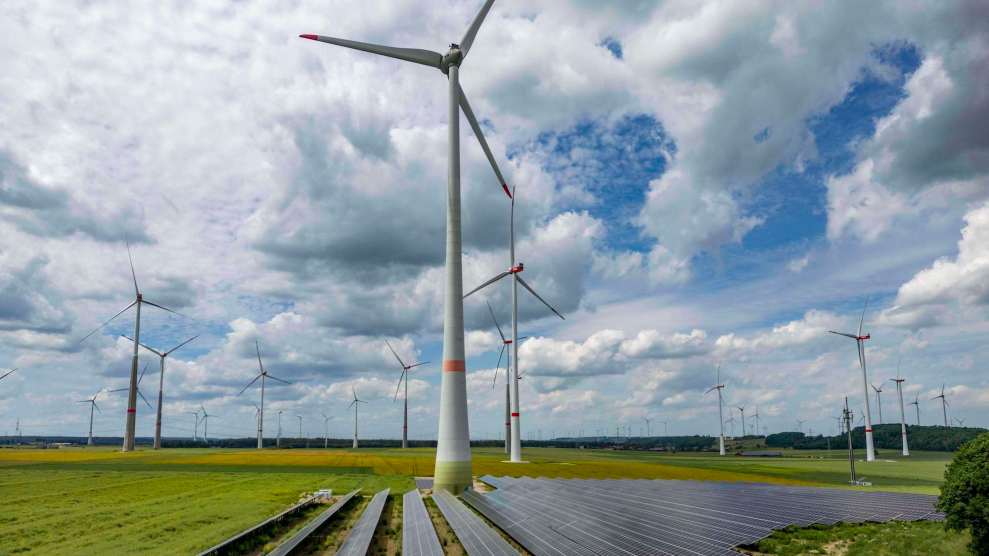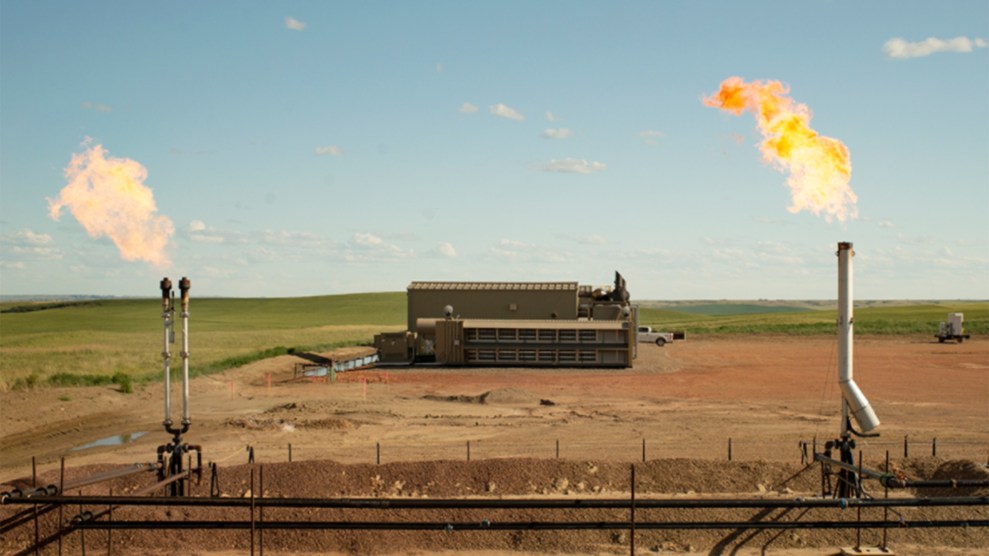
Zuma Press
This story was originally published by Wired and is reproduced here as part of the Climate Desk collaboration.
Big Tech’s appetite for energy is just about visible from the east coast of Scotland. Some 12 miles out to sea sits a wind farm, where each of the 60 giant turbines has blades roughly the length of an American football field. The utility companies behind the Moray West project had promised the site would be capable of generating enough electricity to power 1.3 million homes once completed. That was before Amazon stepped in.
In January, Amazon announced it had struck a deal to claim more than half the site’s 880 megawatts of output, part of its ongoing attempt to slake its unquenchable thirst for power. As the world’s biggest companies race to build the infrastructure necessary to enable artificial intelligence, even remote Scottish wind farms are becoming indispensable.
In Europe last year, $79.4 million was spent on new data center projects, according to research firm Global Data. Already in 2024, there are signs that demand is accelerating. Today Microsoft announced a $3.2 billion bet on Sweden data centers. Earlier this year, the company also said it would double its data center footprint in Germany, while also pledging a $4.3 billion data center investment for AI infrastructure in France. Amazon announced a network of data centers in the state of Brandenburg as part of a $8.5 billion investment in Germany, later dedicating another $17.1 billion to Spain. Google said it would spend $1.1 billion on its data center in Finland to drive AI growth.
“There is a recognition that as power demand increases, the industry will have to find alternative energy sources.”
As the tech giants rush to build more data centers, behind the scenes there is panic around how to power them. Microsoft, Meta and Google all plan to be net zero before 2030, while logistics-heavy Amazon has targeted 2040. In pursuit of that aim, the past decade has seen those companies hoover up renewable energy contracts with wind or solar companies. But all these projects rely on electricity grids, which are buckling under increased demand for clean energy. That’s forcing the tech giants to think about their energy-intensive futures and consider how they might operate their own off-grid power empires, outside the system.
“There is a recognition that as power demand increases, the industry will have to find alternative energy sources,” says Colm Shorten, senior director of data center strategy at real estate services company JLL, explaining that server farms are increasingly looking for “behind-the-wire” power supply, whether that’s gas or diesel generators or more innovative technology such as green hydrogen.
Data centers need power for two primary purposes. The first is to power the chips that enable computers to run algorithms or power video games. The second is to cool the servers, to stop them from overheating and cutting out. Initiatives such as using liquid to cool the chips instead of air are expected to make modest energy savings. But forecasts still expect data centers’ demand for power to as much as double by 2026, according to the International Energy Association, thanks in part to the demands of artificial intelligence.
For the past five years, tech companies have been on an increasingly frenzied shopping spree for renewable contracts known as power purchase agreements (PPAs), which can enable data center operators to reserve power from a wind farm or solar site before the projects have even been built. In Denmark, there are solar farms paid for by Meta. In Norway, there are wind farms bankrolled by Google. As early adopters of these types of deals, tech companies have helped fuel Europe’s now-thriving PPA market, says Christoph Zipf, spokesperson at WindEurope. This month, Microsoft struck the world’s biggest renewables energy deal, signing a $10 billion contract for clean power across Europe and the US.
Yet renewables still need to run through the electricity grid, which is becoming a bottleneck—especially in Europe, as a surge of renewable producers try to connect to feed green transition demand across a multitude of sectors. “We’re going to run into energy constraints,” Meta CEO Mark Zuckerberg predicted on a podcast in April. At Davos this year, OpenAI CEO Sam Altman also warned that the status quo was not going to be able to provide AI with the power it needed to advance. “There’s no way to get there without a breakthrough,” he said at a Bloomberg event.
Grid operators are essentially saying the same thing. Ireland’s state-owned electricity provider Eirgrid cited grid problems when it imposed an effective moratorium on Dublin data centers two years ago. When the municipality of Amsterdam introduced a similar pause, the Dutch Data Center Association, an industry group, hit back. “The current grid congestion in North Holland is blocking the growth of the data center sector,” it said in a statement.
In the search for space on the grid, data centers are being pushed into parts of Europe where their arrival is more conspicuous, risking backlash from the smaller communities when they show up. That trend is already visible in Germany, according to Simon Hinterholzer, researcher at Germany’s Borderstep Institute for Innovation and Sustainability. “In the past, the large majority of new data centers were being built in Frankfurt,” he says. “This has completely changed in the last two or three years.” He points to a 300-megawatt data center being built in the small town of Wustermark, as well as Amazon’s latest investment into Brandenburg, the region bordering Berlin where more than 70 turbines were installed last year.
To cope long-term, there are more calls for data centers to find ways to survive off-grid. “The size of AI projects are getting bigger and bigger, reaching up to 1 gigawatt of power, which cannot be supplied by the traditional power grids,” says Ricardo Abad, founder of data center Quark, which is working on a new site with an unnamed partner in Spain that will be able to generate its own power through on-site solar and wind power. These types of on-site projects are technically still connected to the grid—in case they want to offload excess power—but they have the ability to operate independently, he says.
In the US, Microsoft has already been experimenting with hydrogen fuel cells, touting them as a form of emission-free power back-up.
The same year Dublin announced restrictions on data centers, Amazon also opened its largest-ever on-site solar farm, spanning the roof and car park of its fulfillment center in Seville, Spain. Google’s head of data center location strategy in Europe has also expressed interest in on-site renewables for its next generation of server farms. Microsoft and Meta denied running any projects that are entirely off-grid. But in Dublin, Microsoft is building a data center alongside its own backup gas power plant, meaning the site can keep running even if the grid operator kicks it off.
But Big Tech is really in search of clean energy ideas—even if those ideas are still in their very early stages. “In the future, technologies like advanced nuclear reactors, renewable energy sources, and energy storage solutions will be crucial in making this possible,” says Kilian Wagner, an expert in sustainable digital infrastructures at German digital association Bitkom. OpenAI’s Altman is already an investor in Helion Energy, an American nuclear fusion company that has also agreed to provide Microsoft with 50 megawatts of electricity from its first fusion nuclear plant, once operational. In the US, Microsoft has already been experimenting with hydrogen fuel cells, touting them as a form of emission-free power back-up.
What server farms going off-grid would mean for the rest of us is unclear. By going it alone, Big Tech firms could strike gold in their search for the clean energy source of the future. Until they figure it out, they’re stuck with the grid.














